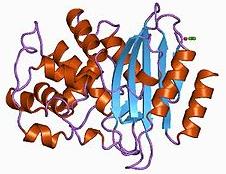Novel Beta-Lactamase Inhibitor

Tech ID
13-046
Inventors
A. King
W. Wang
G. Wright
Patent Status
Australia Patent (AU2014262351B2)
United States Patent (US10016383B2)
Japanese Patent (JP6356227B2)
Contact
Leigh Wilson
Associate Director, New Ventures
Abstract
Resistance to frontline beta-lactam antibiotics (penicillins, cephalosporins, carbapenems) is one of the most pressing public health crises of our time. Beta-Lactamases come in two classes, those that use a Ser at their active site and those that use a Zn2+ metal ion. While inhibitors of Ser beta-lactamases are known and routinely used in combination with various beta- lactam antibiotics in the clinic, there are no effective inhibitors of metallo-beta-lactamases (MBLs) that can be similarly deployed. These MBLs have been relatively rare in the clinic, but in the past decade, the emergence and spread of the NDM alleles of MBLs have gained a significant foothold and are a pressing clinical concern across the globe. The MBL enzymes are increasingly common in Gram negative pathogens, resulting in resistance to virtually all beta-lactam drugs, including last resort carbapenems such as meropenem. They are a particular concern as they inactivate all penicillin, cephalosporin and carbapenem antibiotics.
McMaster University researchers have discovered a potent inhibitor of NDM and other MBLs through a screen of microbial natural products. The compound, aspergillomarasmine A (AMA), inactivates MBLs and with the combination of beta-lactam antibiotics it can be used as an effective therapy to treat infections caused by bacteria harboring MBLs. This combination offers a solution to a significant unmet medical need. There is ample precedent for such a drug combination and the market is well accustomed to such agents. The lack of an effective inhibitor of MBLs represents an innovation gap that is filled by AMA.
Applications & Advantages
- All beta-Lactamase inhibitors in use or in later clinical trials are targeted to serine beta-Lactamases, there are no effective metallo-beta-Lactamase inhibitors
- AMA is the first MBL inhibitor that shows efficacy in vivo and in vitro and have made significant progress to ‘de-risk’ the compound
- Excellent potency and a mode of action that inactivates target MBLs
- Good spectrum of inhibition of the most widespread MBLs
- Excellent in vivo activity and good PK profile that matches carbapenem antibiotics
- No obvious acute toxicity in rodents at high concentrations of compound and no inhibition of ion channels or CYPs
- Low metabolism and no widespread inhibition of concerning human metallo-enzymes such as MMPs or vasodynamic enzymes
- Ready access to highly pure gram quantities of compound from fermentation.


